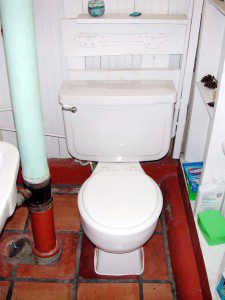
Low-flow toilets made there way in the 1990s when President George H. W. Bush passed an Energy Policy Act that made toilets flush with less water. The law was aimed at residential homes, but in 1994 it slowly spilled over to commercial facilities in 1997. Low-flow or low-flush toilets take about half the amount of water to complete the task in the bathroom, saving billions of gallons of water each year across America.
This concept wasn’t embraced immediately; many complained that it took more flushes to achieve the goal of one flush. The law, however, stayed, and since then, the manufacturers have improved the low-flow toilets quite a bit. Now they can be found everywhere in various colors and designs versus the sterile plain look of white. Newer designs offer smaller bowls that require even less water—making them perfect for small powder rooms or the typical half bath.
The amount of water saved per flush is huge; the standard regular pre-1980s toilet uses about 3.5 gallons of water every flush. A new low-flow or low-flush toilet uses between 1.1 to 1.6 gallons of water. Some newer toilet models come with a regular flush button and a low flow button, so the user can choose how much water is needed at that time. Again, the savings can be big for the environment and the homeowner or the person responsible for the water bill.
Installing one of these toilets is simple and easy, but for those who are simply unable or don’t want to do the dirty deed calling a plumber may be an option. It’s not only good water conservation, but it’s also another way to save money within a household. Renovating a bathroom is a perfect time to change out an old toilet for a new low-flow style. With smells and bacteria build up, it’s generally a good idea to do the upgrade. A low-flow toilet has given homeowners and facilitates a refreshing clean place for the daily user.
